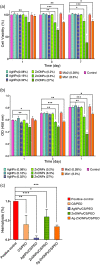Chitosan nanofiber biocomposites for potential wound healing applications: Antioxidant activity with synergic antibacterial effect
- PMID: 35111951
- PMCID: PMC8780905
- DOI: 10.1002/btm2.10254
Chitosan nanofiber biocomposites for potential wound healing applications: Antioxidant activity with synergic antibacterial effect
Abstract
Bacterial wound infection is one of the most common nosocomial infections. The unnecessary employment of antibiotics led to raising the growth of antibiotic-resistant bacteria. Accordingly, alternative armaments capable of accelerating wound healing along with bactericidal effects are urgently needed. Considering this, we fabricated chitosan (CS)/polyethylene oxide (PEO) nanofibers armed with antibacterial silver and zinc oxide nanoparticles. The nanocomposites exhibited a high antioxidant effect and antibacterial activity against Staphylococcus aureus, Escherichia coli, and Pseudomonas aeruginosa. Besides, based on the results of the cell viability assays, the optimum concentration of ZnONPs and AgNPs in the nanofibrous mats is 0.2% w/v and 0.08% w/v respectively and had no cytotoxicity on fibroblast cells. The scaffold also showed good blood compatibility according to the effects of coagulation time. As well as significant fibroblast migration and proliferation on the wound margin, according to wound-healing assay. All in all, the developed biocompatible, antioxidant, and antibacterial Ag-ZnO NPs incorporated CS/PEO nanofibrous mats showed their potential as an effective wound dressing.
Keywords: antibacterial; antioxidant; chitosan/polyethylene oxide nanofibers; electrospun; silver nanoparticles; wound healing; zinc oxide nanoparticles.
© 2021 The Authors. Bioengineering & Translational Medicine published by Wiley Periodicals LLC on behalf of American Institute of Chemical Engineers.
Conflict of interest statement
The authors declare that they have no conflict of interest.
Figures








References
-
- Wang C‐y, Makvandi P, Zare EN, Tay FR, Niu L‐N. Advances in antimicrobial organic and inorganic nanocompounds in biomedicine. Adv Ther. 2020;3(8):2000024. 10.1002/adtp.202000024 - DOI
LinkOut - more resources
Full Text Sources
Molecular Biology Databases
Research Materials

